Medieval History
TIYDK #3: Squire Boone Caverns
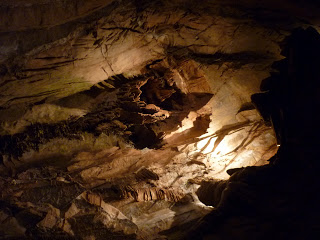 |
| Up |
We lost the heat very quickly (it couldn't possibly follow us all 160 feet down), and then, soon after, we lost a predictable sense of scale, a proper sense of time - gone in the wonder and the questioning and the incredible busyness of caverns. With Tom Sawyer and Becky Thatcher getting lost in that cave, with Oliver giving me a trick for differentiating basic rock formations (stalactites have to hang on tight to stay suspended from the ceiling), with watching
Cave of Forgotten Dreams, caverns have become a place, a particular kind of space where we could bring our bodies to wander within the shifts and grunts and artistry of stone.
 |
| The Big One |
As with so much of natural formation, it's the relentlessness, the insistence, the purposefulness that gets me. It takes a hundred years for a cubic inch of stalactite to create itself (building itself down), longer I think for a stalagmite (building itself up). Here, the two have met, have found each other, have joined, after millions of years. It is a monument to seismic yearning. There is pathos in stone, to be sure (think of the curve and sigh of a medieval sculpture or, go ahead, of a Rodin marble), but desire on this scale, reaching across such a primal gap as space, well, an unbearable heaviness of being comes to mind.
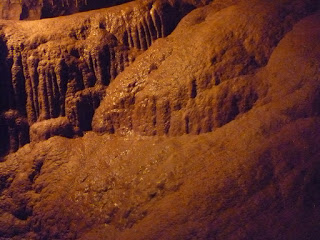 |
| Flow Stone |
What's hard to discern is what is reaching for what exactly. The other parameter you lose is that of matter: which has the agency here, stone or water? It's water that was here in the form of a Mississippian era sea about 350 million years ago, it's sediment that remained to layer itself into stone, it's water that carved out the stone into caverns, it's the stuff of stalactites and stalagmites that is rebuilding walls of stone. There's an ebb and flow, a monumentality, to all this - and so our water and stone metaphors mix. Geological vocabulary is at ease with these hybridities. Behold the flow stone: calcium carbonate remains as water flows over stone and creates a stone that looks to move like water, that stills the time of water's flow, that turns water into stone.
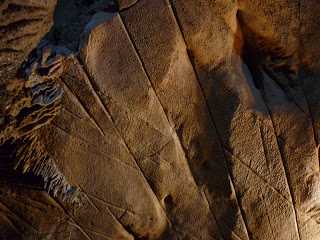 |
| The marks of earth tides |
Earth tides are such a moment, earth tides leave strange markings. They defy my comprehension and I will seek help from my geologist friends, because what I understand so far literally moves the ground beneath my feet. The key line from the Wikipedia entry for me is: "The Earth tide encompasses the entire body of the earth and is unhindered by the thin crust and land masses of the surface, on scales that make the rigidity of rock irrelevant." Jeffrey Cohen's geochoreography comes to life anew! It's a complicated dance to understand involving the gravity of both the sun
and the moon and beautiful phrases like "lunar tidal forcing" (do the stones not want to dance?), but the steps are simple: up and down, and so the Earth's surface moves in re-markable ways: daily, weekly, fortnightly. I already look forward to what the conversation with my colleague, wherein I know already that I will experience what to me is a wondrous phenomenon: a concept that at my first read is inscrutable will, through their patient and metaphorical explanation, click, lock into a sense of scale that I can, at least in their presence with my questions, briefly hold.
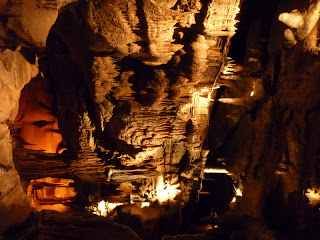 |
| Scale |
So is it the scale that makes "the rigidity of rock irrelevant"? Because I would think that it would make something pretty spectacular make "the rigidity of rock irrelevant." But scale, a shift in perspective, seems rather possible. Although I suppose that the ability to shift perspective (visually, ethically, temporally)
is pretty spectacular. This shot, I'm fairly certain, is on a human scale: that is, we could apprehend all of these forms, we could encircle the thickness of the stalactites with our hands (but we don't touch them, as our guide says, because the oil in our hands would cause the stalactite to stop growing - another question for a geologist!). But I could also choose to see those two vertical forms at the bottom as the size of humans and then everything shifts - and there are huge caverns that leave the human scale far behind. There's a map (I'll have to get a hold of it) that shows all of the caverns in the United States of America, and you can see where the enormous inland sea was millions of years ago, and you notice the line of caverns through Tennessee which seems to exist in some strange echo with the Appalachian mountains. The enormity of the network yawns beneath our feet, known to few living creatures save bats and other near-invisibles.
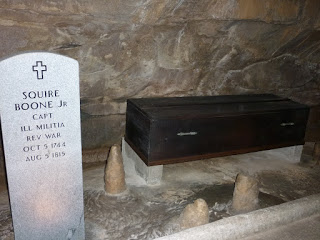 |
| Squire Boone |
And Squire Boone. This is the morbid/mystical part that made these caverns the first of Indiana's for us to visit. In 1790, Squire (his name, given him by his father, an English Quaker who came to Pennsylvania in 1696, and his mother, a Welsh woman who, in bearing Squire, gave birth to the tenth of her eleven children) and his brother Daniel Boone discovered the caverns while eluding "pursuing Indians" (as reads a marker above ground outside the find spot). The caverns became "holy ground" (the marker again) for him and when, many years later in 1809 he returned to build a grist mill and settle down here, he planned for his burial within the cavern. He was originally elsewhere, but the walnut coffin ("hewn (
hewn!) from native timber" reads the marker) disintegrated within the atmospheric conditions (the relentless work of stone and water making wood more than irrelevant). His bones were scattered by various and sundry creatures engaged in their own relentless pursuits, but in the 1970s, when the caverns were being prepared for human visitors, they were regathered (identified by the eleven wounds he had sustained in his days as a pioneer and frontiersman and lived to tell about and have recorded). The original marble marker had also been rapidly devoured by the cavern and just this year a brand new one was installed. The coffin is new (and newly sealed forever) and Squire's remains really truly are inside. You see it on your way into the caverns, but the guide sits you down to talk about it only on your way out. A tiny little girl asked "But how do you
know that's really Jesus in there?" It is clearly VBS (vacation bible school) season in Indiana.
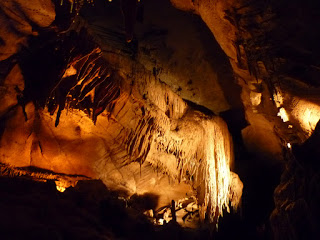 |
| More |
I don't really want to go above ground yet. I want to keep us here a little bit longer, see these seepings fingering their way out of earth tide cracks, listen to the echoes of tiny questions, talk more with Oliver as he considers that the only difference between these constructions and sand castles is time (and a tiny flicker of human agency), think more about the crazed Europeans who grabbed land and claimed rights and found holiness, remain in the increasingly thrilling and excruciating presence of something so fantastic, so willfully complete and morphing.
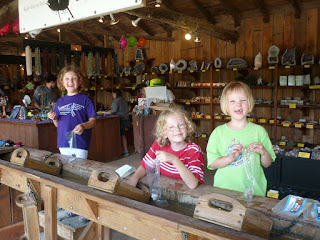 |
| Gem Mining! |
But ok, ok - it's time to go and our babysitter can babysit even today, so the office happily awaits, so let's go back up and see their glee at a bit of gem mining. There's a whole village up around Squire Boone Caverns, including an enormous "Rock Shop." It's all privately owned (as are all the caverns in Indiana) and it's striking: none of the towns around here are big enough to make it on the radar of chain restaurants, you can't take any major highways here from where we are, and so you instantly feel very far away from anywhere else. The owners have made the place a site for gems - they ship to all these different places in the States from here. Who knew?
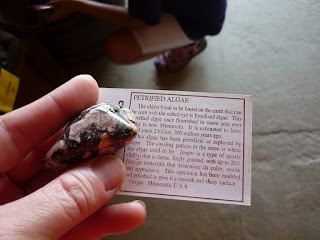 |
| Chosen by humor |
And so I was able to make a little project for the Ecology of Medieval Art class I've been thinking about for a while now into a reality: it's with stones that I want to start the conversation about actor network theory and ecology both, and I'll do it by placing a stone at all places around the seminar table. Some students will just sit down, others will choose their seat based on the stone at its place, and so some of us will have been
moved by stone and so we will need to ask why. As I chose my 20 stones for 20 students, I already had to ask myself about why we would (could even) "choose a stone." Aesthetics in beauty, linguistics in naming, a little bit of humor (Oliver didn't even really stop walking as he passed by and quipped "what scared it so badly?" - see photo above), a more personal reason or desire? It's a microcosm of the class and I need to think about the opening writing prompt a lot more, but it's a start. Strange things are already happening: I love the 20 stones and I know all of their names already (the promising "Aventurine," the delicate but dangerous "Satin Spar," the mysterious "Lodestone"), and can't help but wonder which student will pick which stone, and will I associate that student with that stone and vice versa (I'm going to ask them to keep their stones all semester, as they will be the starting point for several writing prompts). Yet when Iris asked, herself incredulous, "So, are you going to let the students keep them?" I was already kind of sorry that I'd have to let them go.

One last scamper into the woods and a tiny creek and, in the still, hot air, the absolute thrill of feeling a rush of cool, vigorous air and thus finding another cleared opening to the cave, the water visibly rushing out to greet us, but maybe also sending us on our way.
-
Of "lithic Coils" And "petric Pregnancies" - _stone; An Ecology Of The Inhuman_ By Jeffrey Jerome Cohen
Fossils in Viollet-le-Duc's gargoyles of N-D ParisI've just closed the pages of Stone, an Ecology of the Inhuman, a book written (given, it feels) by Jeffrey Jerome Cohen. And so this isn't a review of the book, with measured time and thinking...
-
Thing-power In The Classroom: Stones, Ladders, Spit, Onions, Phalluses And Roses
We've had a new student join our Ecology of Medieval Art class, and it was to him that I turned first in asking for a description of the image on the screen (the same one that you see here). "An arrangement of minerals, stones, and quartz,"...
-
Tiydk #4 & #5: Duckpin Bowling And Glacial Mud
The cats got me up early this morning, so I'm using the time to catch up on The Indiana You Don't Know (TIYDK) entries: two more in the continuing series of escapades that are substituting for a family vacation this year. Truth is, we're...
-
Parting (hewn Redux)
Boucicaut Master, 15th c. Fitzwilliam MuseumI've spent the morning in and out of the Garden of Eden, with Genesis, with Hugh of Saint Victor's Didascalicon, and in and out of modern authors and their takes on it all (a couple of recent vivid examples...
-
Everything And More
Annunciation, 1400s.The meeting with Jim the geologist and Dan the chemist was terrific. This vivid (look at the breath of God!) alabaster Annunciation from the Philadelphia Museum of Art will help here. What is this profound thrill of newly gained knowledge?...
Medieval History

